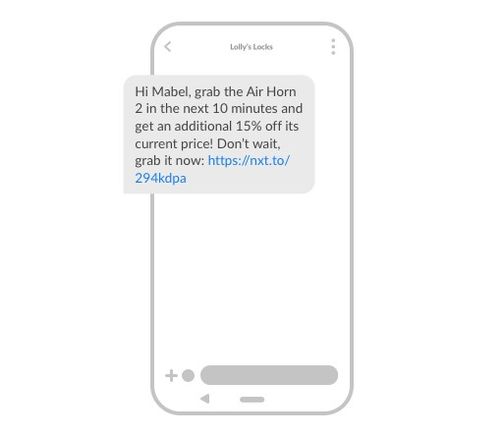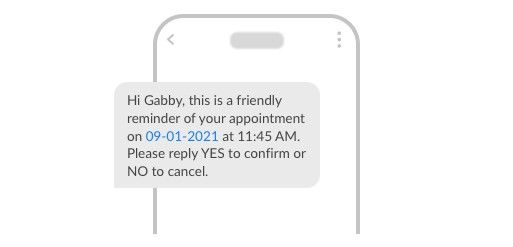Share article:
Why SMS is so effective at prompting action

What was the last text message you received? Was it a friend confirming plans or a loved one telling you about their day? Or was it your electricity company reminding you that your bill is due? Whatever it was, there’s a good chance that you opened it within 90 seconds, read it in its entirety, and maybe even responded right away.
A study by Microsoft found, over the span of 15 years, the average human attention span diminished from 12 seconds to 8 seconds (shorter than a goldfish’s)! This means short messages are more likely to be consumed in full instead of long, wordy paragraphs.
Why do we trust SMS more than some other forms of communication? We are generally more protective over who has our phone number than our email address. When we receive a text message, it’s likely because we opted to hear from the sender. There are compliance regulations in place to protect against unsolicited text message marketing.
Along with the tireless efforts of SMS providers like MessageMedia monitoring for spam, it quickly becomes clear why SMS can be so influential over people’s decision-making: people trust SMS.
Most consumers only consider 1% of their text messages SPAM, so unsubscribe rates stay fairly low. In fact, 75% of people don’t mind receiving promotional SMS as long as they opted-in.
SMS cuts through
MessageMedia’s research identified a strong uptake in customer action after receiving an SMS from a business:
- 59% of respondents reported that they attended an appointment they would have otherwise missed
- 58% paid a bill they would have otherwise forgotten
- 56% visited a store in person or online
An SMS inbox is generally not cluttered with as many marketing messages per day. While SMS marketing campaigns is on the uptake, marketers are warier about sending too many messages. This is likely why it continues to deliver a:
- 98% open rate
- 90% of messages opened within 90 seconds
- 8x the response rate of email
- 85% of American adults own a or smartphone
- 5.25B people in the world have text-enabled phones
Let’s go through some effective SMS marketing tips and three examples for prompting action.
1. SMS for abandoned cart recovery
Ecommerce cart abandonment is one of the most pronounced problems for online sellers today. According to the Baymard Institute, which analysed over 44 different abandonment cart rate reports, the average shopping cart abandonment rate is just shy of 70%. Reports also show that ecommerce brands could regain a whopping $260B from abandoned orders through checkout optimisation.
How it works
A shopper creates an account for an online retailer and peruses the virtual aisles looking at various products. They place one or more in their virtual cart for further consideration or even purchase. For one reason or another, they exit the site without completing their online purchase process.
Later on, they receive a personalised text message prompting them to revisit their shopping cart and complete a transaction. They may also get an incentive of a discount or free shipping if action gets taken within a certain timeframe.
It might look something like this:

What makes it effective
The message is personalised, concise, and incentivising with a clear call to action. It takes about five seconds to take in, and it’s instantly attention-grabbing as it addresses the recipient by name. The message is also specific to their recent shopping experience.
The shopper can revisit their cart right there on their mobile device by tapping on the link provided. This means that no matter where they are, they can act on the impulse to use that discount code and complete their purchase.
Read our case study to learn how Simply For Strings used SMS reminders to increase completed orders by 40%, which resulted in 1000x ROI.
2. SMS for appointment reminders
Most businesses average 10-15% no-shows, but this can go as high as 80% for some industries, including healthcare. For many businesses, this can translate to a hit on profits. Reducing no shows to a business should be a priority. No-shows can have a negative impact in other areas, including overstaffing and client loyalty.
A simple text message reminder automation is a solution to significantly increase attendance rates for upcoming appointments. With added automation, it saves time while ensuring client happiness and better bottom lines.
How it works
An appointment is booked and gets logged in a business’ online calendar or booking system. At a pre-set time before the appointment, an automated SMS is sent to the client, reminding them of their appointment. This can include options to confirm, reschedule or cancel.
A typical example may look something like this:

What makes it effective
Personalisation is at work by addressing the recipient by name. Information about the appointment is presented clearly. Because cancelling by SMS is so effortless, recipients are more likely to do so than having to make a phone call. It also avoids any human interaction, which will appeal to even the most anxious of absentees.
While cancellations may not be ideal, they at least allow you to back-fill the newly available slot or make an adjustment to your roster to minimise unnecessary staffing. This concept can also apply to rostering. Send a text message to let an employee manage upcoming shift availability and confirmations. Keeping communication seamless and straightforward will help keep your customers and staff happy.
In our case study, we found that SMS reminders reduced no-show rates by 43% for US probation officers.
3. SMS for internal staff reminders
In organisations, wasted time means wasted money. You may be waiting for staff to submit timesheets or need to ensure all employees have read an updated HR policy. Waiting for teams to complete required actions can be frustrating, inefficient, and costly.
While other examples here involve some degree of automation, the ad-hoc nature of internal reminders may require a more manual approach. Personalised messages, however, can be composed and distributed to thousands of contacts in just a matter of minutes.
There are many ways to apply SMS for internal staff, so let’s look at one example and discuss the principles and mechanics in play. From there, consider how you can apply this to your organisation.
What makes it effective
Let’s say you’ve been tasked with updating the contact details for all 300 employees at your place of business. This means that you need each employee to either acknowledge their existing details being correct or to provide updated information.
You could do this via email with links to the employee portal to check and update their information. You may risk your request getting lost in a busy inbox. Plus, if no changes are required from an employee, you still need them to acknowledge they have seen your e-mail.
The other option is SMS.
How it works
Export the employee data into a spreadsheet and upload that into the MessageMedia web portal and construct a message using the various headers of the spreadsheet to populate each message with each employee’s personal information. It might read something like this:
“Hi [first_name]. Please confirm your contact information as follows:
Full name: [first_name] [last_name]
Address: [address_1] [address_2] [suburb] [postcode]
Email: [email]
Emergency contact: [emergency_name] [emergency_number]
Reply “YES” if correct, or “NO” if incorrect.”
There are more features to help with this process, including automated follow-up messages or tracking message responses. The main takeaway is the employee’s request has been made extremely clear, and completing it is low-effort, which increases the likelihood of them doing so.
Final thoughts, further reading
Sending an SMS campaign prompts action because not only is texting a trusted means of communication, it also plays to our natural behaviours. When utilised effectively, they provide a low-effort way to engage with customers.
Billions of text messages get sent every day. It’s a part of everyday life, so incorporating SMS messages into your marketing channel mix makes sense. We have seen businesses succeed by complementing an email marketing strategy with SMS.
